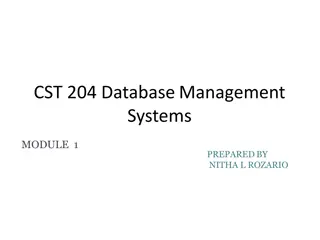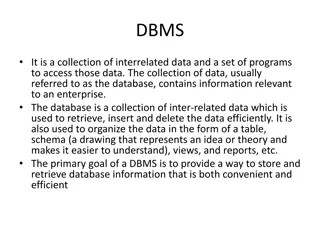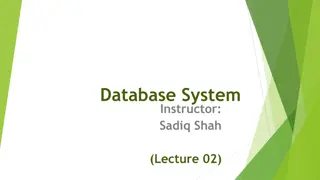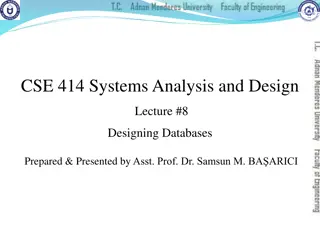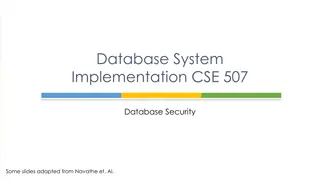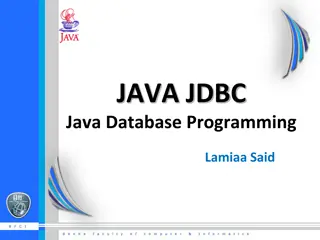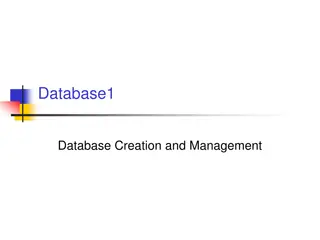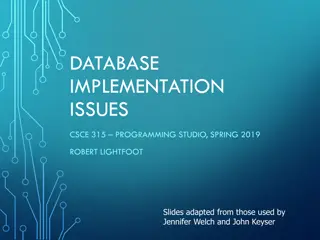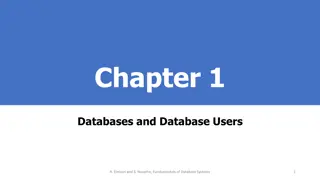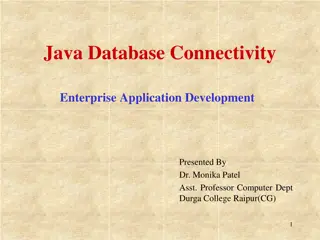Introduction to Database Systems
This course covers topics such as disk access time, rows and records in tables, file organization, indexing methods, dense and sparse indexes, primary and secondary indexes, and more. The content delves into the fundamentals of database systems, with a focus on efficient data retrieval techniques and indexing strategies like B+-trees and ISAM. Gain insights into how data is stored and accessed, and learn about different types of indexes and their advantages in database management.
Download Presentation

Please find below an Image/Link to download the presentation.
The content on the website is provided AS IS for your information and personal use only. It may not be sold, licensed, or shared on other websites without obtaining consent from the author.If you encounter any issues during the download, it is possible that the publisher has removed the file from their server.
You are allowed to download the files provided on this website for personal or commercial use, subject to the condition that they are used lawfully. All files are the property of their respective owners.
The content on the website is provided AS IS for your information and personal use only. It may not be sold, licensed, or shared on other websites without obtaining consent from the author.
E N D
Presentation Transcript
CS 405G: Introduction to Database Systems Instructor: Jinze Liu Fall 2017
Review The unit of disk read and write is Block (or called Page) The disk access time is composed by Seek time Rotation time Data transfer time 3/1/2025 Jinze Liu @ University of Kentucky 2
Review A row in a table, when located on disks, is called A record Two types of record: Fixed-length Variable-length 3/1/2025 Jinze Liu @ University of Kentucky 3
Review In an abstract sense, a file is A set of records on a disk In reality, a file is A set of disk pages Each record lives on A page Physical Record ID (RID) A tuple of <page#, slot#> 3/1/2025 Jinze Liu @ University of Kentucky 4
Todays Topic How to locate data in a file fast? Introduction to indexing Tree-based indexes ISAM: Indexed sequence access method B+-tree 3/1/2025 Jinze Liu @ University of Kentucky 5
Basics Given a value, locate the record(s) with this value SELECT * FROM R WHERE A = value; SELECT * FROM R, S WHERE R.A = S.B; Other search criteria, e.g. Range search SELECT * FROM R WHERE A > value; Keyword search database indexing Search 3/1/2025 Jinze Liu @ University of Kentucky 6
Dense and sparse indexes Dense: one index entry for each search key value Sparse: one index entry for each block Records must be clustered according to the search key 3/1/2025 Jinze Liu @ University of Kentucky 7
Dense versus sparse indexes Index size Sparse index is smaller Requirement on records Records must be clustered for sparse index Lookup Sparse index is smaller and may fit in memory Dense index can directly tell if a record exists Update Easier for sparse index 3/1/2025 Jinze Liu @ University of Kentucky 8
Primary and secondary indexes Primary index Created for the primary key of a table Records are usually clustered according to the primary key Can be sparse Secondary index Usually dense SQL PRIMARY KEY declaration automatically creates a primary index, UNIQUE key automatically creates a secondary index Additional secondary index can be created on non-key attribute(s) CREATE INDEX StudentGPAIndex ON Student(GPA); 3/1/2025 Jinze Liu @ University of Kentucky 9
Tree-Structured Indexes: Introduction Tree-structured indexing techniques support both range selections and equality selections. ISAM =Indexed Sequential Access Method static structure; early index technology. B+ tree: dynamic, adjusts gracefully under inserts and deletes. 3/1/2025 Jinze Liu @ University of Kentucky 10
Motivation for Index ``Find all students with gpa > 3.0 If data file is sorted, do binary search Cost of binary search in a database can be quite high, Why? Simple idea: Create an `index file. index entry Index File kN k2 k1 P0 K1 Pm P1 K2 P2 Km Data File Page N Page 3 Page 1 Page 2 Can do binary search on (smaller) index file! Jinze Liu @ University of Kentucky 3/1/2025 11
ISAM What if an index is still too big? Put a another (sparse) index on top of that! ISAM (Index Sequential Access Method), more or less Example: look up 197 100, 200, , 901 Index blocks 100, 123, , 192 200, 901, , 996 100, 108, 119, 121 123, 129, 192, 197, 200, 202, 901, 907, 996, 997, Data blocks 3/1/2025 Jinze Liu @ University of Kentucky 12
Updates with ISAM Example: insert 107 Example: delete 129 100, 200, , 901 Index blocks 100, 123, , 192 200, 901, , 996 100, 108, 119, 121 123, 129, 192, 197, 200, 202, 901, 907, 996, 997, Data blocks 107 Overflow block Overflow chains and empty data blocks degrade performance Worst case: most records go into one long chain 3/1/2025 Jinze Liu @ University of Kentucky 13
A Note of Caution ISAM is an old-fashioned idea B+-trees are usually better, as we ll see But, ISAM is a good place to start to understand the idea of indexing Upshot Don t brag about being an ISAM expert on your resume Do understand how they work, and tradeoffs with B+- trees 3/1/2025 Jinze Liu @ University of Kentucky 14
B+-tree A hierarchy of intervals Balanced (more or less): good performance guarantee Disk-based: one node per block; large fan-out Max fan-out: 4 100 120 150 180 30 179 180 120 156 100 101 130 150 200 110 11 30 35 5 3 3/1/2025 Jinze Liu @ University of Kentucky 15
Sample B+-tree nodes to keys 100 k Max fan-out: 4 150 180 120 Non-leaf to keys 100 <=k < 120 to keys to keys to keys 180 <= k 120 <=k < 150 150 <= k < 180 120 130 Leaf to next leaf node in sequence to records with these k values; or, store records directly in leaves 3/1/2025 Jinze Liu @ University of Kentucky 16
B+-tree balancing properties Height constraint: all leaves at the same lowest level Fan-out constraint: all nodes at least half full (except root) Max # Max # pointers Non-leaf Root Leaf active pointers 2 f Min # Min # keys f 1 f 1 f 1 keys 2 / f 1 f f f / 2 f 1 / 2 / 2 f 3/1/2025 Jinze Liu @ University of Kentucky 17
Lookups SELECT * FROM R WHERE k = 179; SELECT * FROM R WHERE k = 32; Max fan-out: 4 100 120 150 180 30 Not found 179 179 180 120 156 100 101 130 150 200 110 11 30 35 5 3 3/1/2025 Jinze Liu @ University of Kentucky 18
Range query SELECT * FROM R WHERE k > 32 AND k < 179; Max fan-out: 4 100 120 150 180 30 Look up 32 179 180 120 120 156 156 100 100 101 101 130 130 150 150 200 110 110 11 30 35 35 5 3 And follow next-leaf pointers 3/1/2025 Jinze Liu @ University of Kentucky 19
Insertion Insert a record with search key value 32 Max fan-out: 4 100 120 150 180 30 Look up where the inserted key should go 32 179 180 120 156 100 101 130 150 200 110 11 30 35 5 3 And insert it right there 3/1/2025 Jinze Liu @ University of Kentucky 20
Another insertion example Insert a record with search key value 152 Max fan-out: 4 100 120 150 180 152 179 156 120 180 100 101 130 150 200 110 Oops, node is already full! 3/1/2025 Jinze Liu @ University of Kentucky 21
Node splitting Max fan-out: 4 100 Yikes, this node is also already full! 120 150 156 180 150 179 120 180 130 100 152 156 101 200 110 3/1/2025 Jinze Liu @ University of Kentucky 22
More node splitting Max fan-out: 4 156 100 180 120 150 150 179 120 180 130 100 152 156 101 200 110 In the worst case, node splitting can propagate all the way up to the root of the tree (not illustrated here) Splitting the root introduces a new root of fan-out 2 and causes the tree to grow up by one level 3/1/2025 Jinze Liu @ University of Kentucky 23
Insertion B+-tree Insert Find correct leaf L. Put data entry onto L. If L has enough space, done! Else, must splitL (into L and a new node L2) Distribute entries evenly, copy upmiddle key. Insert index entry pointing to L2 into parent of L. This can happen recursively Tree growth: gets wider and (sometimes) one level taller at top. 3/1/2025 Jinze Liu @ University of Kentucky 24
Deletion Delete a record with search key value 130 Max fan-out: 4 100 If a sibling has more than enough keys, steal one! 120 150 180 Look up the key to be deleted 179 156 120 180 100 101 130 150 200 110 And delete it Oops, node is too empty! 3/1/2025 Jinze Liu @ University of Kentucky 25
Stealing from a sibling Max fan-out: 4 100 156 Remember to fix the key in the least common ancestor 120 150 180 179 120 150 180 100 156 101 200 110 3/1/2025 Jinze Liu @ University of Kentucky 26
Another deletion example Delete a record with search key value 179 Max fan-out: 4 100 120 156 180 150 179 120 180 100 156 101 200 110 Cannot steal from siblings Then coalesce (merge) with a sibling! 3/1/2025 Jinze Liu @ University of Kentucky 27
Coalescing Max fan-out: 4 100 Remember to delete the appropriate key from parent 120 156 180 180 150 120 100 156 200 101 110 Deletion can propagate all the way up to the root of the tree (not illustrated here) When the root becomes empty, the tree shrinks by one level 3/1/2025 Jinze Liu @ University of Kentucky 28
Deletion B+-tree Delete Start at root, find leaf L where entry belongs. Remove the entry. If L is at least half-full, done! If L has only d-1 entries, Try to redistribute, borrowing from sibling (adjacent node with same parent as L). If re-distribution fails, mergeL and sibling. If merge occurred, must delete entry (pointing to L or sibling) from parent of L. Tree shrink: gets narrower and (sometimes) one level lower at top. 3/1/2025 Jinze Liu @ University of Kentucky 29
Example B+ Tree - Inserting 8* Root Root 17 30 24 13 17 24 30 5 13 33* 34* 38* 39* 2* 3* 19* 20* 22* 24* 27* 29* 5* 7* 8* 14* 16* 33* 34* 38* 39* 19* 20* 22* 24* 27* 29* 3* 5* 2* 7* 14* 16* Notice that root was split, leading to increase in height. In this example, we can avoid split by re-distributing entries; however, this is usually not done in practice. 3/1/2025 Jinze Liu @ University of Kentucky 30
Example Tree (including 8*) Delete 19* and 20* ... Root Root 17 30 24 13 17 24 30 5 13 33* 34* 38* 39* 33* 34* 38* 39* 19* 20* 22* 24* 27* 29* 3* 3* 5* 2* 2* 7* 14* 16* 7* 19* 20* 22* 24* 27* 29* 5* 8* 14* 16* 3/1/2025 Jinze Liu @ University of Kentucky 31
Example Tree (including 8*) Delete 19* and 20* ... Root Root 17 17 27 30 5 13 24 30 5 13 33* 34* 38* 39* 2* 3* 22* 24* 27* 29* 5* 7* 8* 14* 16* 33* 34* 38* 39* 2* 3* 19* 20* 22* 24* 27* 29* 5* 7* 8* 14* 16* Deleting 19* is easy. Deleting 20* is done with re-distribution. Notice how middle key is copied up. 3/1/2025 Jinze Liu @ University of Kentucky 32
... And Then Deleting 24* Must merge. Observe `toss of index entry (key 27 on right), and `pull down of index entry (below). 30 39* 22* 27* 38* 29* 33* 34* Root 5 13 17 30 33* 34* 38* 39* 3* 22* 27* 29* 2* 5* 7* 8* 14* 16* 3/1/2025 Jinze Liu @ University of Kentucky 33
Performance analysis How many I/O s are required for each operation? h, the height of the tree (more or less) Plus one or two to manipulate actual records Plus O(h) for reorganization (should be very rare if f is large) Minus one if we cache the root in memory How big is h? Roughly logfan-outN, where N is the number of records B+-tree properties guarantee that fan-out is least f / 2 for all non-root nodes Fan-out is typically large (in hundreds) many keys and pointers can fit into one block A 4-level B+-tree is enough for typical tables 3/1/2025 Jinze Liu @ University of Kentucky 34
B+-tree in practice Complex reorganization for deletion often is not implemented (e.g., Oracle, Informix) Leave nodes less than half full and periodically reorganize Most commercial DBMS use B+-tree instead of hashing- based indexes because B+-tree handles range queries 3/1/2025 Jinze Liu @ University of Kentucky 35
The Halloween Problem Story from the early days of System R UPDATE Payroll SET salary = salary * 1.1 WHERE salary >= 100000; There is a B+-tree index on Payroll(salary) The update never stopped (why?) Solutions? Scan index in reverse Before update, scan index to create a complete to-do list During update, maintain a done list Tag every row with transaction/statement id 3/1/2025 Jinze Liu @ University of Kentucky 36
B+-tree versus ISAM ISAM is more static; B+-tree is more dynamic ISAM is more compact (at least initially) Fewer levels and I/O s than B+-tree Overtime, ISAM may not be balanced Cannot provide guaranteed performance as B+-tree does 3/1/2025 Jinze Liu @ University of Kentucky 37
B+-tree versus B-tree B-tree: why not store records (or record pointers) in non-leaf nodes? These records can be accessed with fewer I/O s Problems? Storing more data in a node decreases fan-out and increases h Records in leaves require more I/O s to access Vast majority of the records live in leaves! 3/1/2025 Jinze Liu @ University of Kentucky 38
Beyond ISAM, B-, and B+-trees Other tree-based indexes: R-trees and variants, GiST, etc. Hashing-based indexes: extensible hashing, linear hashing, etc. Text indexes: inverted-list index, suffix arrays, etc. Other tricks: bitmap index, bit-sliced index, etc. How about indexing subgraph search? 3/1/2025 Jinze Liu @ University of Kentucky 39
Summary Two types of queries Key-search Range-query B+-tree operations Search Insert Split child Delete Redistribution B+-tree sorting Next: disk-based sorting algorithms 3/1/2025 Jinze Liu @ University of Kentucky 40

 undefined
undefined




